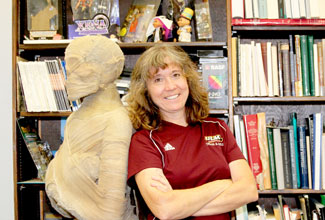Published August 07, 2014
Dr. Mónica Bontty, associate professor of history at the University of Louisiana at
Monroe, recently attended the 16th Annual University of California-Los Angeles (UCLA)
"St. Shenouda the Archimandrite Coptic Conference."
According to Bontty, the term Coptic refers to the largest Christian minority in modern
Egypt. Coptic comes from the final stage of the ancient Egyptian language, which was
spoken from about 3200, B.C. to about the thirteenth century, A.D.
The two-day conference was sponsored by the St. Shenouda the Archmandrite Coptic Society
and the Department of Near Eastern Languages and Cultures at UCLA.
Bontty said, "This annual event is open to the general public and gives scholars the
opportunity to present the latest research on St. Shenouda, an Egyptian monk and monastic
leader who lived from 345 to 465 who has been falsely characterized by some as a harsh,
violent, and not particularly intellectually sophisticated individual."
Bontty specializes in ancient cultures
Bontty continued, "Shenouda was fluent in Coptic and Greek and was acquainted with
the works of Aristotle and Aristophanes."
"He also led a community of male and female monks from 385 to 465…"He wrote prolifically,
producing numerous sermons, letters, treatises and monastic rules, which are among
the most important written sources for the study of the history, economy and religion
of Late Antique Egyptian society."
Bontty suggests that characters such as St. Shenouda and his struggles versus his
enemies help keep students engaged, and doing research and participating in conferences,
keeps her up-to-date with recent scholarship in their fields and allows them present
these discoveries in history courses.
Bontty received her bachelor’s degree in Ancient Near Eastern Civilizations, her master’s
degree in Near Eastern Languages and Cultures, and her doctorate in Near Eastern Languages
and Cultures with a specialization in Egyptology, all from UCLA. She also took courses
in Coptic language at UCLA and in Germany, which triggered her interest in the history
of monasticism and St. Shenouda.
"Although my area of expertise is highly specialized (ancient Egyptian hieroglyphs
and Coptic languages,) I bring as much of it as I can into the history classroom,"
says Bontty.
Bontty added that she looks forward to sharing information on Coptic and pharaonic
Egypt with ULM students, local schoolteachers, enthusiasts or anyone one else interested
in these topics.

